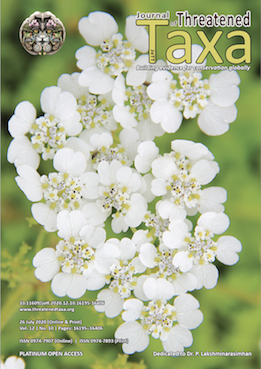Tracing heavy metals in urban ecosystems through the study of bat guano - a preliminary study from Kerala, India
DOI:
https://doi.org/10.11609/jott.6225.12.10.16377-16379Keywords:
Bio-indicator tool, flying mammals, metal pollution, non-invasiveAbstract
Abstract: Bat guano serves as a potential bio-indicator tool for accessing the heavy metals contamination level in bats. Such a non-invasive tool also permits an assessment of the plausible risks of heavy metal pollution among wildlife, humans, and the ecosystem. The study provides the first assessment of metals such as mercury, chromium, copper, manganese, and nickel in bat guano from the Indian state of Kerala, thus providing us valuable information on the quality of the environment.
References
Clark, D.R., Jr. (1981). Bats and Environmental Contaminants: A Review. USDA Fish and Wildlife Service Special Scientific Report-Wildlife, Washingdon D.C. No. 235.
Ma, W.C. & S. Talmage (2001). Insectivora, pp. 123–158. In: Shore, R.F. & B.A. Rattner (eds.). Ecotoxicology of Wild Mammals. John Wiley & Sons, New York, 752pp.
Jones, G., D.S. Jacobs, T.H. Kunz, M.R. Willig & P.A. Racey (2009). Carpe noctem: the importance of bats as bioindicators. Endangered Species Research 8: 93–115. https://doi.org/10.3354/esr00182
Martin, D.B. (1992). Contaminant studies on endangered bats in northeastern Oklahoma. U.S. Fish and Wildlife Service report, Ecological Services, Tulsa, Oklahoma, 16pp.
Allinson, G., C. Mispagel, N. Kajiwara, Y. Anan, J. Hashimoto, L. Laurenson, M. Allinson & S. Tanabe (2006). Organochlorine and trace metal residues in adult Southern Bent-wing Bat (Miniopterus schreibersiibassanii) in southern Australia. Chemosphere 64: 1464–1471. https://doi.org/10.1016/j.chemosphere.2005.12.067
Klaassen, C.D. (1976). Biliary excretion of metals. Drug Metabolism Reviews 5: 165–196.
Hernout, B.V., C.J. McClean, K.E. Arnold, M. Walls, M. Baxter & A.B.A. Boxall (2016). Fur: a non-invasive approach to monitor metal exposure in bats. Chemosphere 147: 376–381. https://doi.org/10.1016/j.chemosphere.2015.12.104
Zukal, J., J. Pikula & H. Bandouchova (2015). Bats as bioindicators of heavy metal pollution: history and prospect. Mammalian Biology 80: 220–227.
Published
Issue
Section
License
Authors own the copyright to the articles published in JoTT. This is indicated explicitly in each publication. The authors grant permission to the publisher Wildlife Information Liaison Development (WILD) Society to publish the article in the Journal of Threatened Taxa. The authors recognize WILD as the original publisher, and to sell hard copies of the Journal and article to any buyer. JoTT is registered under the Creative Commons Attribution 4.0 International License (CC BY), which allows authors to retain copyright ownership. Under this license the authors allow anyone to download, cite, use the data, modify, reprint, copy and distribute provided the authors and source of publication are credited through appropriate citations (e.g., Son et al. (2016). Bats (Mammalia: Chiroptera) of the southeastern Truong Son Mountains, Quang Ngai Province, Vietnam. Journal of Threatened Taxa 8(7): 8953–8969. https://doi.org/10.11609/jott.2785.8.7.8953-8969). Users of the data do not require specific permission from the authors or the publisher.





